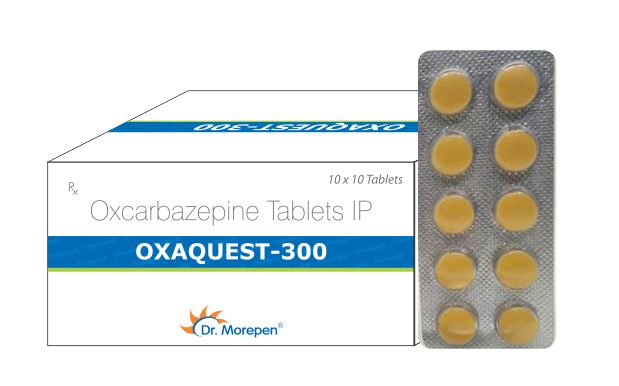Therapeutic Indication
Partial-Onset Seizures
Pharmacology
Mechanism of Action:
Oxcarbazepine is an anticonvulsant drug that reduces the incidence of seizures in epilepsy by inhibiting abnormal electrical activity in the brain.
The exact mechanism through which oxcarbazepine and its active metaoblite, MHD, exert their anti-epileptic effects is unclear, but is thought to primarily involve the blockade of voltage-gated sodium channels. The opening and closing of sodium channels allows for the propagation of action potentials along neurons - in epilepsy, these action potentials can occur in excess of that required for normal function, and the repetitive and pathological firing of these action potentials leads to seizure activity. Both oxcarbazepine and MHD are thought to inhibit seizure activity by binding to the inactive state of voltage-gated sodium channels, thus prolonging the period in which the receptor is unavailable for action potential propagation. This helps to stabilize hyperexcited neuronal membranes, inhibit repetitive neuron firing, and prevent the spread of seizure activity within the CNS without affecting normal neuronal transmission. Increased potassium conductance and modulation of voltage-activated calcium channels is also thought to play a role in the anti-seizure activity of oxcarbazepine.
Pharmacokinetics:
Absorption: Oxcarbazepine is completely absorbed following oral administration.
Volume of distribution: The apparent volume of distribution of oxcarbazepine is 49 L
Protein binding: The pharmacologically active metabolite of oxcarbazepine, MHD, is approximately 40% bound to plasma proteins, predominantly albumin
Metabolism: Oxcarbazepine is rapidly and extensively metabolized to its primary metabolite, MHD, which is responsible for the bulk of its anti-epileptic activity and exists in much higher concentrations in the plasma than the parent drug
Only 10% of an administered dose of oxcarbazepine will remain as either the parent drug or glucuronide conjugates of the parent drug
Route of elimination: Following oral administration, more than 95% of the administered dose of oxcarbazepine is found in the urine. Of this, approximately 49% is MHD glucuronide metabolites, 27% is unchanged MHD, 3% is inactive DHD metabolites, 13% is conjugated oxcarbazepine, and less than 1% is unchanged parent drug. Fecal elimination accounts for only 4% of the administered dose.
The plasma half-life of oxcarbazepine is approximately 2 hours and the plasma half-life of MHD is approximately 9 hours.
Side Effects
Common side effects include:
● Skin rash
● Fever
● Swollen glands
● Flu-like symptoms
● Muscle aches
● Severe weakness
● Unusual bruising
● Yellowing of your skin or eyes
Contraindication
The drug should not be used in the following conditions:
● Depression, suicidal ideation
● Hyponatremia Renal failure, renal impairment
● Driving or operating machinery
● Geriatric
● Pregnancy
● Breast-feeding
Interaction
Following drugs may interact with oxcarbazepine:
● Naproxen
● Zolpidem
● Duloxetine
● Erythromycin
● Fish Oil (omega-3 polyunsaturated fatty acids)
● Ibuprofen
● Lamotrigine
● Escitalopram
● Pregabalin
● Esomeprazole
● Prednisone
● Acetaminophen
● Vitamin B12 (cyanocobalamin)
● Vitamin D3 (cholecalciferol)
● Cetirizine
● Alprazolam
Disclaimer:The data uploaded is made from content already available on internet.The company holds no right of it and is not responsible for any wrong information.
